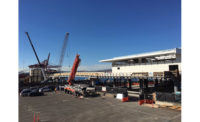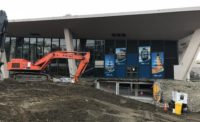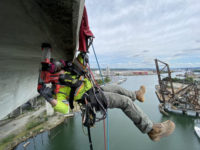Robotic Parking Structure Coming to Seattle Cancer Center
Robotic Parking Structure Coming to Seattle Cancer Center

When GLY Construction expands the Fred Hutchinson Cancer Research Center campus for the Seattle Cancer Care Alliance in Seattle’s South Lake Union, they’ll do so by using a three-level robotic parking garage, the largest in the Pacific Northwest, and one of the largest by scope and scale on the West Coast.
As part of an expansion project scheduled to open in 2022, Bellevue, Wash.-based GLY will demolish a pair of two-story buildings, and the parking lot between them, immediately west of the campus’ main cancer treatment center. A 150,000-sq-ft, six-story building, described by the Seattle office of ZGF Architects as long and narrow, will be constructed in its place, with an automated parking system in a below-grade pit under the expansion. The expansion, which will be used primarily for cancer patients and families, will include a pedestrian bridge connection to the main center.
Joe Walker, GLY project executive, says they are excited to bring robotic parking to Seattle, but it required some research on their part. “This has been a tremendous planning process that included traveling with SCCA to two garages of similar size and scale—in Budapest, Hungary, and Munich, Germany—where we confirmed our desire to move forward with this efficient, multipurpose solution.”
GLY is partnering with German-based WÖHR and Denver subcontractor Harding Steel to build the WÖHR Multiparker 730 system.
With the new service, patients will drop off their vehicle with a centralized valet who will transport the car to one of the garage’s three stories with robotic lifts and platforms that shift cars vertically and horizontally, allowing for between 160 and 180 parking spots, all closer together than at a traditional garage and without the need for ramps. The design creates a fresh solution for the center, which is struggling with maximizing urban space.
“It’s really a time-tested technology,” says Taka Soga, ZGF Architects principal. “It’s unusual for this region and the United States generally, but these garages are common in Europe and in Asia, where the site footprints tend to be more constricted.”
Terry McDonnell, chief nurse executive and vice president of clinical operations at Seattle Cancer Care Alliance, expects the parking experience at the clinic to have a “positive impact to our patients and families” as the center works to improve patients’ experience through the facility’s every aspect.
The garage will require a shallower excavation than a standard parking garage, which also saves money, an important consideration given the area’s high water table, Soga says. The design will also result in less of a construction impact. All floors of the robotic garage are flat, instead of the sloped floors and ramps found in a traditional garage.
“We found this to be a cost-neutral or even cost-saving approach,” Soga says. Other cost savings include fewer building systems and lights, since the public is not allowed in the parking area.
The system is able to be disassembled and repurposed for a new use should driving habits change.





